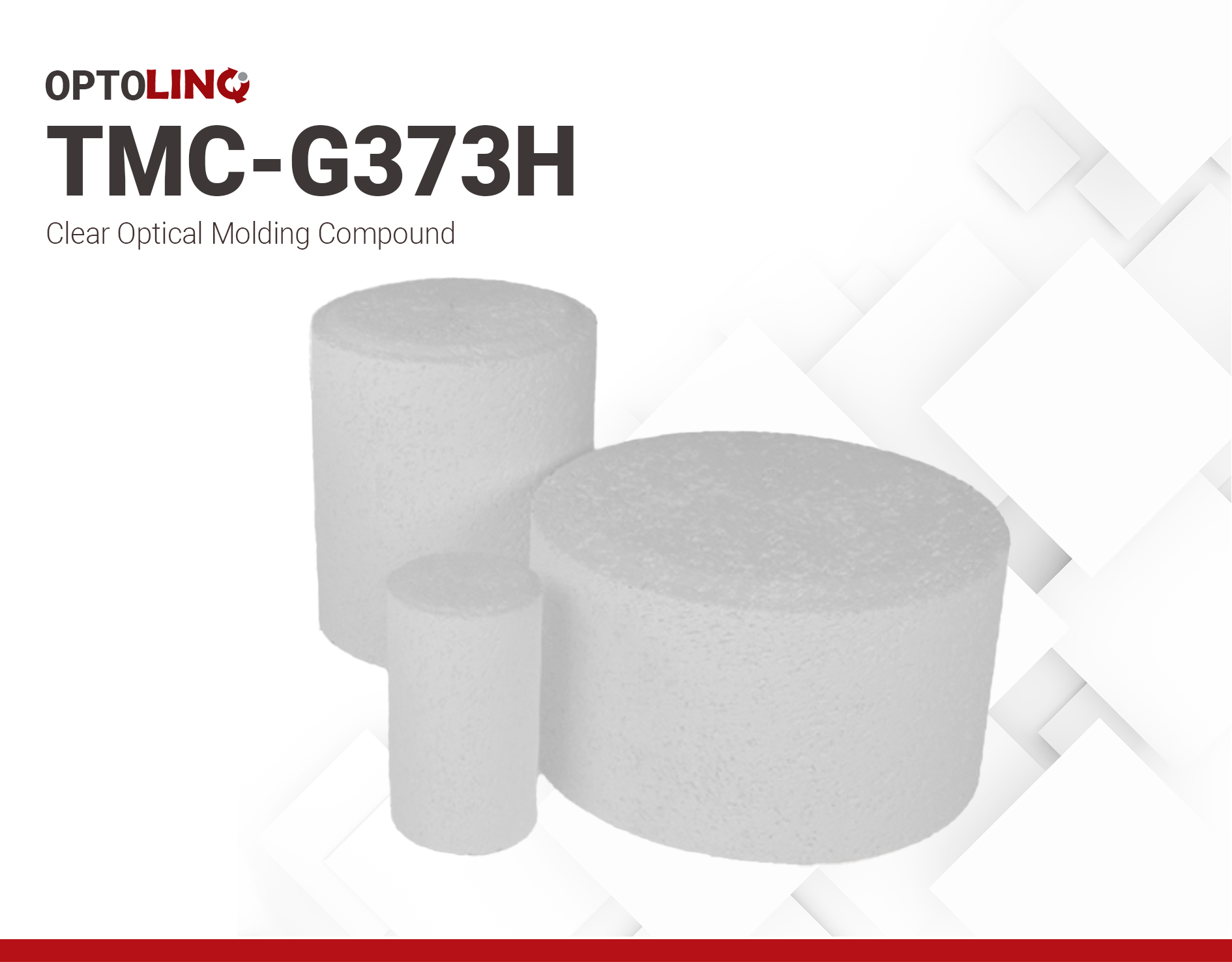TMC-G373H | Transparent Epoxy Molding Compound
- Exceptional moldability with waxed formulation
- Low moisture absorption even at high temperature and high humidity conditions
- Excellent solder resistance for reliability
Product Description
OPTOLINQ TMC-G373H is an optically clear epoxy molding compound specifically designed for the encapsulation of optoelectronic devices. With its high spiral flow, it ensures precise and intricate molding. OPTOLINQ TMC-G373H also offers high moisture resistance, maintaining performance even in high temperature and humidity conditions.
This product stands out with its self-releasing technology and solder resistance for reliability, ensuring good quality and precision in optoelectronic device molding. Overall, OPTOLINQ TMC-G373H is well-suited for the encapsulation of packages that require optical transparency. TMC-G373H is available is custom pellet sizes. Contact us for more information.
Product Key Features
- Optimal spiral flow — fills mold completely and uniformly.
- Excellent moldability — capable of forming into complex shapes and geometry.
- High reliability — allows encapsulated component to function reliably under stress.
Technical Specifications
| General Properties | |||||||||
| Appearance Appearance Appearance at room temperature. | White | ||||||||
| Refractive index Refractive index The refractive index determines how much the path of light is bent, or refracted, when entering a material. It is calculated by taking into account the velocity of light in vacuum compared to the velocity of light in the material. The refractive index calculation can be affected by the wavelength of light and the temperature of the material. Even though it is usually reported on standard wavelengths it is advised to check the TDS for the precise test parameters. | 1.56 | ||||||||
| Specific Gravity Specific Gravity Specific gravity (SG) is the ratio of the density of a substance to the density of a reference substance; equivalently, it is the ratio of the mass of a substance to the mass of a reference substance for the same given volume. For liquids, the reference substance is almost always water (1), while for gases, it is air (1.18) at room temperature. Specific gravity is unitless. | 1.15-1.25 | ||||||||
| Thermal Properties | |||||||||
| Glass Transition Temperature (Tg) Glass Transition Temperature (Tg) The glass transition temperature for organic adhesives is a temperature region where the polymers change from glassy and brittle to soft and rubbery. Increasing the temperature further continues the softening process as the viscosity drops too. Temperatures between the glass transition temperature and below the decomposition point of the adhesive are the best region for bonding. The glass-transition temperature Tg of a material characterizes the range of temperatures over which this glass transition occurs. | 100 °C | ||||||||
| |||||||||
| |||||||||
| Electrical Properties | |||||||||
| Visible Light Transmission | 90 % | ||||||||
| Mechanical Properties | |||||||||
| Molded Shrinkage | 1.5 % | ||||||||
| |||||||||
| |||||||||
| |||||||||
| Chemical Properties | |||||||||
| Moisture absorption | 0.25 % | ||||||||
| Curing Conditions | |||||||||
| Transfer Pressure | 0.31-0.41 Kg/mm2 | ||||||||
| Transfer Time | 40-60 s | ||||||||
| |||||||||
| |||||||||
| Physical Properties | |||||||||
| Spiral Flow @ 175°C | 80-220 cm | ||||||||
Additional Information
Processing Instructions
- Before use, allow TMC-G373H to reach room temperature (20±5 °C, 40±15% RH) for a minimum of 24 hours for larger pellets and 12 hours for smaller ones, ensuring the bag remains unopened to prevent moisture contamination.
- For TMC-G373H in larger sizes, preheating can be performed using standard RF equipment. Preheating must be done slowly to achieve uniform temperature.
- Prior to molding with TMC-G373H or any new material, the mold should be cleaned thoroughly. To prepare the mold, the initial three shots should be cured for 5–10 minutes. After this initial preparation period, you can reduce the curing time to a level that provides sufficient hot hardness for effective release.
Storage and Handling
OPTOLINQ TMC-G373H is available in pressed pellets in a wide range of sizes to meet specific customer needs. To ensure product integrity, keep it away from oxidizing materials. For long-term storage, maintain a cold environment, ideally at –10 °C or lower. The shelf life under this condition is 6 months.
The technical information presented in this document is provided for reference only and does not constitute a guarantee of specific properties or performance. Actual results may vary depending on individual conditions and application methods. Users are strongly advised to perform their own testing and validation to determine suitability for their intended use and compliance with relevant regulations.



